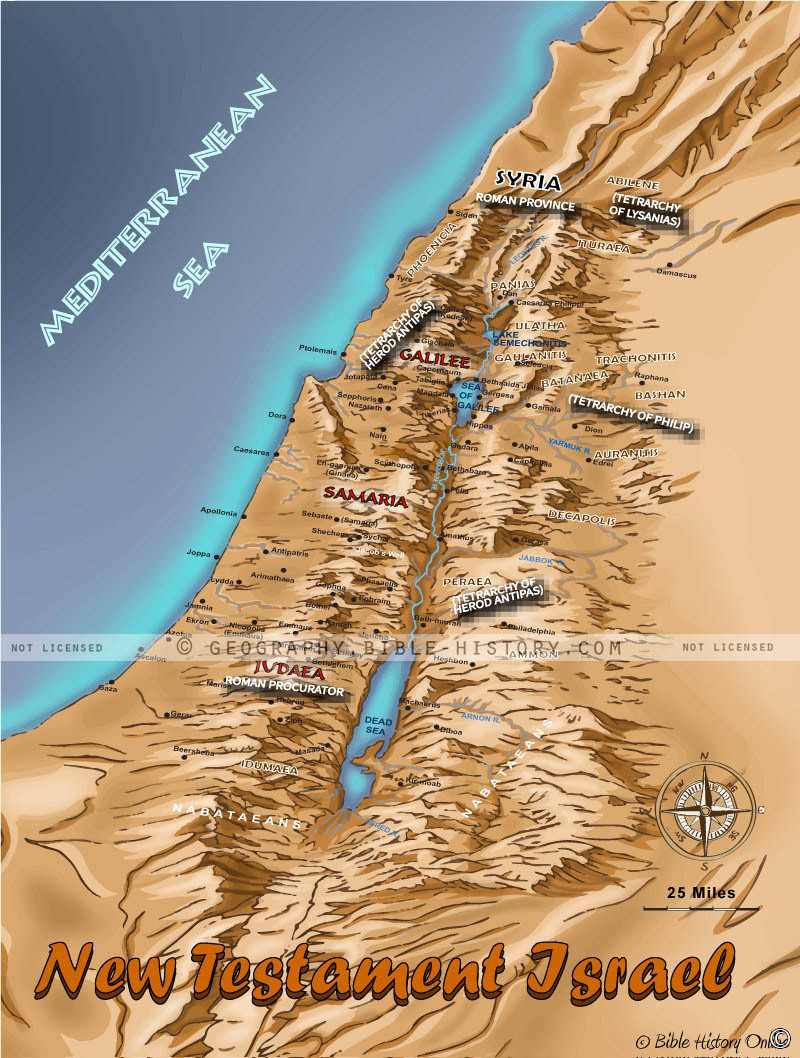
The map of New Testament Israel provides a captivating visual representation of the geographical landscape where the events of the New Testament unfolded. It offers a detailed exploration of the region, cities, and landmarks that played a pivotal role in the life and teachings of Jesus Christ and the early Christian community. Here is a description of this historical map:
Geographical Scope:
This map offers a comprehensive view of the geographical extent of New Testament Israel, encompassing regions in the eastern Mediterranean, particularly modern-day Israel and Palestine. It includes the territories that were part of the ancient Roman province of Judea and its neighboring regions.
Prominent Cities and Landmarks:
The map highlights key cities and landmarks that hold profound significance in the New Testament narratives. It prominently features Jerusalem, the spiritual and political center, along with other iconic places such as Bethlehem, Nazareth, Capernaum, and the Sea of Galilee.
Religious and Historical Significance:
This map serves as a visual testament to the religious and historical significance of these places in Christianity. It reflects the locations where pivotal events from the New Testament took place, including the birth of Jesus, his ministry, crucifixion, and resurrection.
Routes and Journeys:
It outlines the routes and journeys of Jesus, his disciples, and early Christian missionaries as they traveled throughout New Testament Israel, spreading the message of faith and salvation.
Cultural and Social Context:
The map provides insights into the cultural, social, and political context of New Testament Israel during the time of the Roman Empire. It reflects the diversity of populations and religious beliefs in the region.
Religious Communities:
The map may also indicate the locations of early Christian congregations, synagogues, and places of worship, offering a glimpse into the growth of Christianity in these urban centers.
Archaeological Discoveries:
Incorporating markers or references to archaeological discoveries and excavations in these places can provide tangible evidence of the historical accuracy of New Testament accounts and the enduring legacy of early Christianity.
The map of New Testament Israel invites viewers to step into the heart of the biblical world, where the life and teachings of Jesus Christ and the growth of the early Christian community left an indelible mark on history. It allows them to explore the geography, history, and cultural context of these iconic places, deepening their understanding of the events and stories that have profoundly influenced Christian faith and tradition.
Blank Topo Map of The World
Abraham’s Journey
The Captivity of Judah (586-516 B.C.)
The Fall of Judah 586 B.C.
The Northern Kingdom of Israel
The Southern Kingdom of Judah
The Divided Kingdom
The Fertile Crescent
Ur of the Chaldees
Shechem in Old Testament Times
Prophets, Kings, and Nations
Jesus Last Passover
New Testament Israel
New Testament Places
Old Testament Israel
Provinces of the Roman Empire
Israel during David’s Kingdom
David’s Kingdom
Cities of the New Testament 4
Cities of the New Testament 3
Cities of the New Testament 2
Mediterranean Sea
Cities of the New Testament
First Century Jerusalem
Empire of David and Solomon
David’s Kingdom
Israel Under Rehoboam
Ophir and Tarshish
The Period of the Kings
Ramoth Gilead
Samaria
Solomon’s Temple
Zarephath and MT Carmel
Jabesh Gilead and Tribes
Judah in the Time of David
Kingdom of Saul
Kirjath Jearim
Michmash
Mount Gilboa in the Time of David
Nob Davids Flight
Shiloh
Israel and Judah
Assyrian Empire Under Esarhaddon
Assyrian Empire Under Sennacherib
Captivity of 10 Tribes
Events in 2 Kings
The Khabur River
Israel and Syria
Captives From Judah
Kingdom of Jeroboam
Mesha’s Kingdom
Pharaoh Necho Battles King Josiah at Megiddo
Babylonian, Mede and Persian Empires
Samaria and Nearby Territories
Syria at its Height
Hebron
Mahanaim
1949 Map of Israel With Boundaries
First & Second Journeys of Paul
Journeys of the Apostles
Paul’s Third Missionary Journey
Saul’s Journey to Damascus and Arabia
Paul’s Final Visits
Paul’s 1st Missionary Journey
Paul’s 2nd Missionary Journey
Paul’s 3rd Missionary Journey
Paul’s Voyage to Rome
Phillip Journeys to Samaria and Gaza
Judah at the Time of Amos
Empire of Alexander the Great
Israel Under the Maccabees
Galilee During Maccabees
Idumea Intertestamental Period
Kingdom of the Ptolemies
Kingdom of the Seleucids
Ptolemaic Egypt Seleucid Asia
The Roman World
Kingdom of Ptolemies and Seleucids
The World During the 6TH Century BC
Mount Horeb
The Red Sea
The Exodus
Ezra’s Journey to Restore Jerusalem
Israel and Judah During Hosea’s Time
The Ancient World
Canaan During the Time of Abraham
The City of Shechem
Supposed Location of the Garden of Eden
The Land of Israel in Genesis
The Jordan River
The Kingdom of Nimrod
Mount Ararat and Mesopotamia
The Descendants
Sodom and Gomorrah
The Kingdom of Egypt
The Hamites
The Kingdom of the Hittites
Ur of the Chaldees
Judah at the Time of Haggai
Jesus Passes Through Samaria
